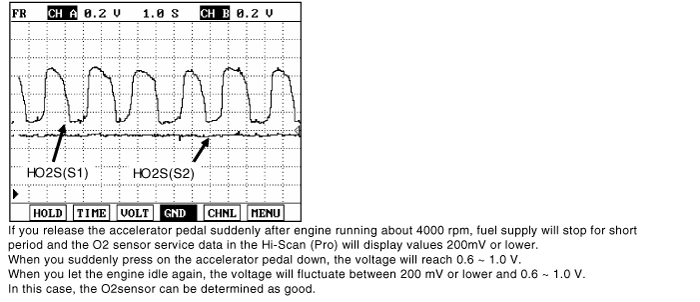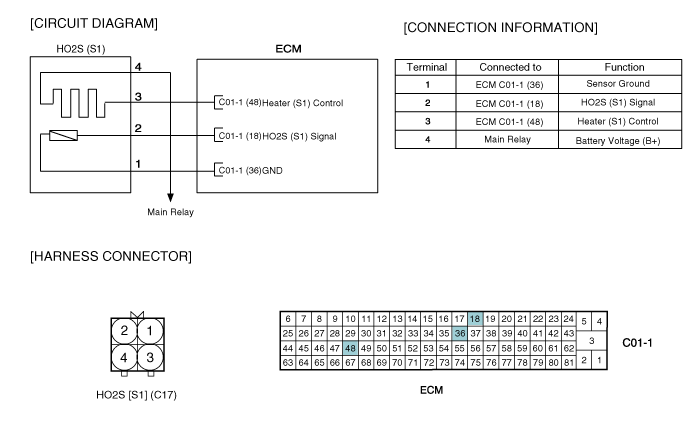Monitor "HO2S(B1S1)" parameter on scantool.


The heated oxygen sensors are mounted on the front side and the rear sied of Catalytic Converter (warm-up catalytic converter), which detects the oxygen concentration in the exhaust gas. The front HO2S signal is used to control air/fuel ratio (closed loop fuel control) and the rear HO2S signal is used to monitor front HO2S and catalyst for proper operation. The heated oxygen snesor (HO2S) produces a voltage that varies between 0V and 1V. When the air/fuel ratio is lean, the oxygen concentration in the exhaust gas increases and the front HO2S outputs a low voltage (approximately 0 ~ 0.1 V).When the air/fuel ratio is rich, the oxygen concentration in the exhaust gas decreases and the front HO2S output a high voltage (approximately 0.8 ~ 1 V). The ECM constantly monitors the HO2S and increases or decreases the fuel injection duration by using the HO2S signal, which is called closed-loop fuel control operation.
If there is abnormal response rate of HO2S under enable conditions, ECM sets DTC P0133.
( This DTC might be caused by the malfunction of Heater circuit, so, check the heater circuit first. )
Item | Detecting Condition | Possible Cause |
DTC Strategy | ● Response rate | ● Poor connection ● leak or clog in intake air system ● Injector ● Fuel pressure ● B1S1 ● ECM |
Enable Conditions | ● Engine speed 1800∼2800rpm ● Engine load 30∼65% ● Exhaust gas temperature (model) 〉 450℃ | |
Threshold Value | ● Cycle period of B1S1 signal 〉 3 sec | |
Diagnostic Time | ● 12 cycle | |
MIL | ● ON |
※ B1S1 : upstream oxygen sensor / B1S2 : downstream oxygen sensor

A/F Ratio | Output Voltage (V) |
Rich | 0.6 ~ 1.0V |
Lean | 0 ~ 0.4V |

Connect scantool to DLC (Data Link Cable).
Warm up the engine to normal operating temperature.
Monitor "HO2S(B1S1)" parameter on scantool.

Is the "HO2S(B1S1)" parameter displayed correctly?

▶ Fault is intermittent caused by poor contact in the sensor’s and/or ECM’s connector or was repaired and ECM memory was not cleared. Thoroughly check connectors for looseness, poorconnection, ending, corrosion, contamination, deterioration, or damage. Repair or replace asnecessary and go to "Verification of Vehicle Repair" procedure.

▶ Go to "Terminal and Connector Inspection" procedure.
This DTC might be caused by the malfunction of Heater circuit, so, check the heater circuit first.
Check leakage or clog of air.
Check contamination, clog and installation of gasket
▶ Any damage or installation of throttle body gasket.
▶ Any damage or installation of gasket between intake manifold and surge tank.
▶ Clog or contamination of intake manifold and injector by foreign materials
▶ Contamination and open stuck between surge tank and PCSV by foreign materials
▶ Any damage or contamination of HO2S(B1/S1) by foreign materials.
Has a problem been found?

▶ Go to " Check Fuel Line" as follows.

▶ Repair or replace as necessary and then, go to "Verification of Vehicle Repair" procedure.
Check Fuel Line.
Check Clog, contamination and installation of Fuel Line as follows.
▶ Connection for each connectors in Fuel Line.
▶ Damage, interference and installation of vaccum hose connected to Fuel Line.
▶ Bend, Leakage and squeeze of pipe in Fuel Line.
Has a problem been found?

▶ Go to "Check Fuel Pressure" as follows.

▶ Repair or replace as necessary and then, go to "Verification of Vehicle Repair" procedure.
Check Fuel Pressure.
IG "OFF".
Disconnect fuel pump relay from junction box in passenger compartment.
Start engine and await until engine is off and then, IG "OFF".
Connect fuel pump relay again.
Connect fuel pressure gauge on the fuel filter with fuel pressure gauge adaptor.
Start engine again and measure fuel pressure.
Specification : Approx. 3.5㎏/cm²
Is the fuel pressue normal?

▶ Go to "Component Inspection" procedure.

▶ Check any damage of fuel return hose or pipe.
▶ Check any stuck of the valve in the fuel pressure regulator.
▶ Repair or replace as necessary and then, go to 'Verification of Vehicle Repair" procedure.
Check PCV.
IG "OFF"
Disconnect PCV.
Check that PCV is properly operating.
Is the PCV O.K?

▶ Go to "Check PCSV" as follows.

▶ Substitute with a known - good PCV and check for proper operation.
▶ If the problem is corrected, replace PCV and go to "Verification of Vehicle Repair" procedure.
Check the PCSV.
Ignition "OFF".
Disconnect PCSV and Vacuum Hose.
Apply vacuum on PCSV with Hand Vacuum Gauge.
Is the PCSV keeping the Vacuum?

▶Go to "Check Injector" as below.

▶Substitute with a known-good PCSV and check for proper operation. If the problem is corrected, replace PCSV and then go to "Verification of Vehicle Repair" procedure.
Check Injector.
Ignition "OFF"
Remove Injector.
Check Leakage and clog on Injector.
Measure resistance terminal 1 and 2 of Injector connector(Component side).
ITEM | Resistance [Ω] |
Coil Resistance | 13.8 ~ 15.2Ω at 20℃ (68℉) |

Is the measured resistance within specifications?

▶ Go to "Check sensors related to Fuel Trim " as below.

▶ Substitute with a known-good Injector and check for proper operation. If the problem is corrected, replace Injector and then go to "Verification of Vehicle Repair" procedure.
Check Sensors related to Fuel Trim.
Check the Input Voltage of Sensors related to Fuel Trim(MAPS, TPS, ECTS, PCSV, Injector, and etc) - Refer to Trouble Shooting Guide -
Are the sensors related to Fuel Trim O.K?

▶ Go to "Check ECM" as below.

▶ Repair as necessary and go to "Verification of Vehicle Repair" procedure.
Check ECM.
IG "OFF" and disconnect B1S1 connector.
Connect scantool and Key "ON".
Select simulation function on scantool.
Simulate voltage at terminal 2 of HO2S(B1S1) sensor signal connector.

Is the HO2S(B1/S1) signal value changed according to simulation voltage ?

▶ Thoroughly check connectors for looseness, poor connection, bending, corrosion, contamination,deterioration, or damage. Repair or replace as necessary and then go to "Verification of VehicleRepair" procedure.

▶ Substitute with a known-good ECM and check for proper operation.
▶ If the problem is corrected, replace ECM and then go to "Verification of Vehicle Repair" procedure.
After a repair, it is essential to verify that the fault has been corrected.
Connect scan tool and select "Diagnostic Trouble Codes(DTCs)" mode.
Clear the DTCs and Operate the vehicle within DTC Enable conditions in General information.
Are any DTCs present ?

▶ Go to the applicable troubleshooting procedure.

▶ System is performing to specification at this time.